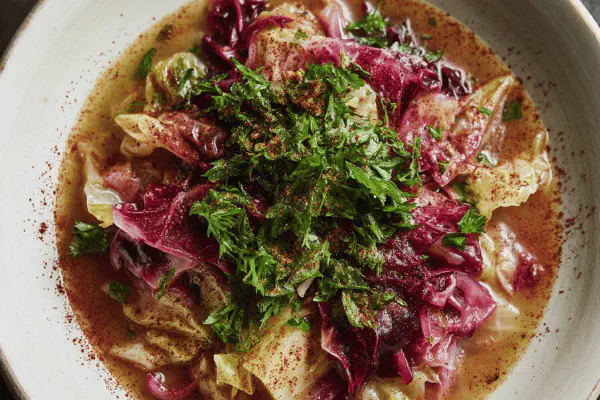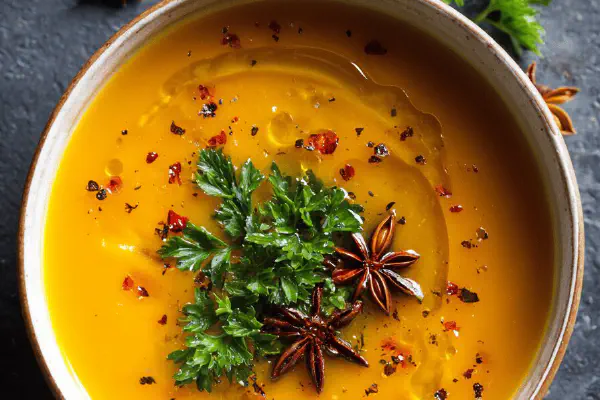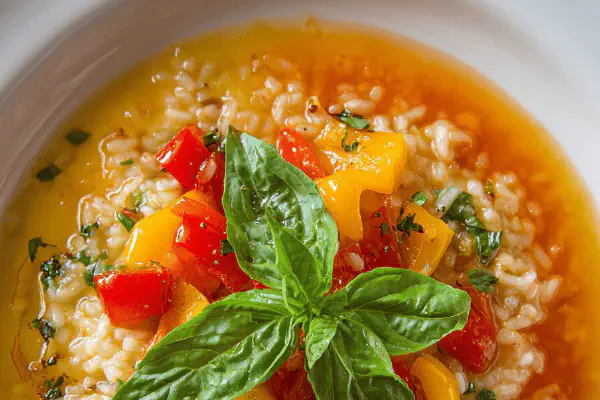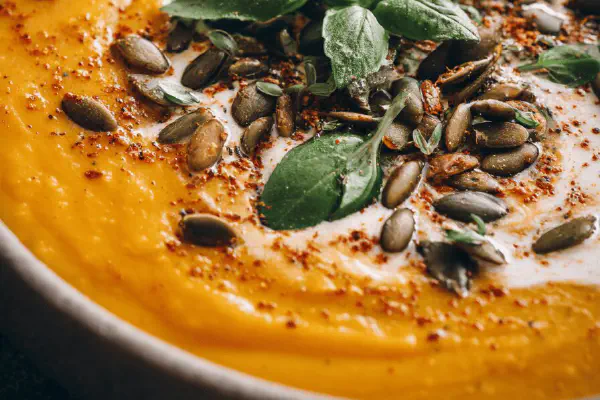Cabbage Beet Soup

E
By Emma
Certified Culinary Professional
•
Recipe tested & approved
A rustic cabbage and beet soup with a subtle sweet and tangy edge. Onion caramelized with brown sugar and deglazed with white wine vinegar builds a sharp base. Root vegetables simmered in chicken broth until tender. Cabbage slices wilted just right, retaining slight crunch. Fresh flat-leaf parsley added at the end for brightness. Hearty, colorful, slightly earthy flavors balanced by vinegar’s punch. Gluten, dairy, nuts, and eggs free. Simple, seasonal ingredients transformed by controlled caramelization and acid layering. Adjust timing by eye—soft but not mushy vegetables. My twist: swapped chicken broth to vegetable broth for deeper umami and added a pinch of smoked paprika for warmth. Versatile and forgiving soup, great for cooling days or a starter.
Prep:
25 min
Cook:
35 min
Total:
60 min
Servings:
4 to 6 servings
#soup
#vegetarian
#vegan
#gluten-free
#French-inspired
#slow simmer
#root vegetables
#comfort food
Starting with a hot pan full of onions sliced thin — hear the soft sizzle when they hit the oil. That smell, a bit sweet, a bit savory, signals the base of everything to come. Brown sugar over the onions? Yes, it’s old-school but necessary, a caramel crust building flavor no bland broth can match. Deglazed aggressively with white wine vinegar, the sharp bite wakes up the pot. Potatoes and earthy beets sliced just so, folding into the simmerhead of green cabbage layers. Timing? Don’t rush it, but don’t lose the snap. That cabbage translucency, that beet color seeping into the broth — the visual part of knowing you’re close. Parsley dropped at the end for a punch of green freshness, because no one wants a dull soup. Tried swapping chicken broth to vegetable years ago, gave the whole bowl a rustic depth I keep coming back to. Smoked paprika? Little secret I toss in when the nights start to turn colder.
Ingredients
- 1 onion sliced thin
- 30 ml olive oil
- 10 ml brown sugar
- 30 ml white wine vinegar
- 1.2 litres vegetable broth
- 2 potatoes peeled and diced
- 2 medium beets peeled julienned (about 2 cups)
- 500 ml shredded green cabbage
- 60 ml chopped flat-leaf parsley
- Salt and pepper
- 1/2 tsp smoked paprika (optional)
About the ingredients
Careful peeling the beets — those juices stain like crazy. Use gloves or rub with lemon after if your fingers turn red. Brown sugar is better than white here, brings a molasses hint. Olive oil should be good quality, extra virgin blocking the bitterness. For broth, chicken works fine but vegetable broth adds more earthiness that pairs well with beets. Vinegar choice is personal, white wine vinegar cuts sharp but gentle; apple cider vinegar or sherry vinegar would shift the profile if you want different. The cabbage should be fresh and firm, not floppy olds leaves. Parsley just before serving keeps it lively, drops in last minute only — herbs lose punch if cooked long. If you want a vegan spin, the broth and no honey variant fits perfectly without losing soul.
Method
- Heat olive oil in a heavy pot until shimmering. Add sliced onions and stir until they start to soften and color, about 7 minutes. Look for golden edges, not burnt spots.
- Sprinkle brown sugar over onions. Stir quickly while it melts and caramelizes; a sticky amber layer will coat the pan. Smell the sweet notes rising.
- Pour in the vinegar to deglaze, scraping the bottom to lift caramel bits. The sizzling hiss and sharp tang cut through the sweetness — essential contrast.
- Add diced potatoes, julienned beets, shredded cabbage to the pot. Season with salt, pepper, and smoked paprika if using. Stir all for even coating and blending flavors.
- Pour the vegetable broth in, enough to cover vegetables by about a finger. Don’t drown the color and texture. Bring just to a boil — bubbling and rising steam.
- Lower heat to maintain a gentle simmer. Cover loosely and cook, stirring occasionally, for roughly 30 minutes. Check vegetables, they should be tender enough to pierce but keep some bite.
- Look for softened beets deepening broth color and cabbage turning translucent but not mushy. Taste broth for seasoning adjustment; acid-sugar balance may need tweak.
- Add chopped parsley near the end to preserve bright green notes and fresh aroma. Stir through, turn off heat, let sit covered a couple minutes for flavor marriage.
- Serve hot with crusty bread or as is. If thicker soup preferred, mash some potatoes against the side of the pot for natural body.
- Possible substitutions: use red wine vinegar for stronger tang, swap parsley with dill or cilantro for different herbaceous lift, vegetable broth hosts better earthiness than chicken stock, can omit paprika if no heat desired.
Cooking tips
The key is patience with onions: too fast cooking burns, too slow dries. Caramelizing is a dance, look for gold, smell it—don’t stop until you see a sticky glaze coating the pan. Deglaze promptly with vinegar; don’t let sugar scorch or you’ll get bitterness. When adding potatoes and beets, keep sizes consistent for even cooking. Simmer rather than boil hard — gentle bubbles preserve shape and prevent a mushy mess. Stir every 8-10 minutes to avoid sticking. Cabbage last — it wants short cooking to keep body, usually 15 minutes max dependable. Taste mid-way to balance salt and acidity. Parsley endgame is easy; throw it in, cover, the residual heat wakes it up without cooking away the fresh taste. If thicker texture wanted, mash a bit of potato in the pot after removing heat—the starch thickens naturally and adds creaminess without cream. Experimentation is welcome; I throw in smoked paprika or cumin when feeling bold. Keep an eye on color and aroma — better indicators than clock minutes alone.
Chef's notes
- 💡 Onions need patience. Low heat, stir often. Watch edges turn golden, no burnt spots. Sticky sugar glaze is key. Don’t rush caramelizing or flavors dull and bitterness grows.
- 💡 Vinegar after sugar melts. Hot pan, sharp hiss cuts sweetness quick. Deglaze by scraping pan bottom real good to lift fond. Use white wine vinegar for bright acid; apple cider or sherry shift flavor drastically.
- 💡 Cut veggies evenly. Potatoes and beets sized similarly to cook in harmony. Simmer gentle bubbles, not roiling boil, or mushy mess happens. Stir every 8-10 minutes for texture control.
- 💡 Cabbage folds into broth late, short cooking preserves crunch. Overcooked cabbage wilt turns floppy, loses color. Look for translucent leaves with snap still intact – timing by eye, no timer rule.
- 💡 Parsley at finish only, no early cooking. Toss in last minute before turning off heat. Keeps color vibrant, fresh aroma wakes up dish. Optional smoked paprika gives warmth, skip if heat unwanted but adds depth.
Common questions
Why caramelize onions slow?
Builds flavor layers. Fast cooking burns sugar, bitter notes. Slow draws out sweetness, sticky coating forms. Timing varies, smell and texture clues better.
Can I swap broth?
Yes. Veg broth adds earthiness, chicken broth lighter. Use what’s on hand. Broth depth shifts final taste. Vegetable stock richer with beets, better base generally.
How avoid mushy veggies?
Gentle simmer mandatory. No rolling boil. Stir every so often. Check doneness with fork, keep bite. Uniform dice helps all cook same pace. Patience matters here.
How store leftovers?
Refrigerate covered 3–4 days. Reheat gently, add splash broth if thickened too much. Freeze possible but texture shifts in cabbage a bit. Eat sooner for best.



